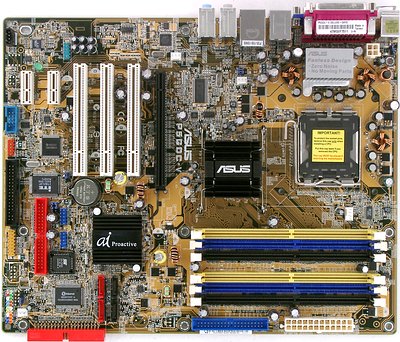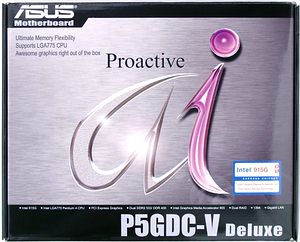ASUS P5GDC-V Deluxe – Mainboard based on Intel 915G Chipset
|
This top mainboard based on i915G Express looks impressive in comparison with competing products based on more "prestigious" chipsets (for example, i925X). This model is interesting not only by its rich periphery connectivity capacities, but also by its support for both memory types. How it affects its performance – read the chapter with preliminary test results.

The number of IDE/SATA slots dooms this mainboard to poor layout, but this is probably the only noticeable drawback of the PCB layout. Access to some of the jumpers may be hampered when the mainboard is in a case, there in no brief description of their functions on the PCB. +5 V Standby on the mainboard is indicated by a green LED – you must not touch the "innards" of the system until the power on the mainboard is off. The 4-phase switching voltage regulator of the processor incorporates one 1500 uF capacitor, four 1000 uF capacitors, and several ones of a lesser capacity. The mainboard also contains voltage regulators for PCIEx16 (two 1000 uF capacitors) and memory (four 1000 uF capacitors, reinforced by inductors).
At the time this review was written, ASUS had only two mainboards based on i915G including P5GD1-VM (mATX), which we already reviewed. It's obviously not correct to compare them directly, but what is more interesting – the mainboard under review is almost identical to P5GDC Deluxe/Pro based on i915P – these are the only ASUS models for two memory types. P5GDC Pro is much less complex, and both Deluxe mainboards differ only in chipsets, they even have the same PCB layout. These cards have vacant seats for the second COM port on a bracket (it is not soldered in any mainboard) and the S/PDIF jack. Mainboard dimensions – 305x245 mm (full-sized ATX, nine-screw mount, all mainboard edges are firmly fixed). The Winbond W83627EHF-A chip is used to monitor:
- CPU voltage, +3,3, +5 and +12 V
- RPM of 4 fans (with an option to enable Q-Fan for two of them)
- CPU and board temperatures (by the corresponding embedded sensors)
Onboard ports, sockets, and connectors
- CPU socket (Socket 775 supporting all state-of-the-art processors including Celeron D)
- 2 x DDR2 SDRAM DIMM (up to 2 GB DDR2-400/533, module capacities from 256 MB, supported memory frequency of 600 MHz, which is however almost pointless) and 4 x DDR SDRAM DIMM (up to 4 GB DDR333/400, module capacities from 256 MB), only modules of one memory type can be used at a time
- 1 x PCIEx16 (with a latch)
- 2 x PCIEx1
- 3 x PCI
- Power connectors: standard EPS12V (24 pins, you can connect a regular 20-pin connector in case you don't use powerful up-to-date componentry like top PCIE video cards) and 4-pin for 12 V
- 1 x FDD
- 3 x IDE (Parallel ATA) – one of them is in the chipset (for 2 ATA100 devices), the other two operate thanks to an additional controller, connected disks (4 ATA133) can form RAID 0, 1 or 0+1
- 4 x SATA (Serial ATA) – all of them are in the chipset, connected disks can form two independent RAID 0, 1 or Matrix RAID
- 2 connectors for brackets with additional USB (2.0) ports
- Connector for a bracket with FireWire port
- Game-port connector
- COM-port connector
- Connector for a chassis intrusion sensor
- 1 x CD/DVD audio connector
- Header for the bracket with additional Audio-Outs
- 4 x fan headers (all with RPM control)
Back panel (left to right, blockwise)

- PS/2 mouse and keyboard
- 1 LPT, Toslink and Coaxial S/PDIF-Out, 1 D-Sub (VGA)
- 2 x USB and FireWire
- 2 x USB and 1 x RJ-45 (Gigabit Ethernet)
- 3 x Audio (Center/Sub, Rear, Side)
- 3 x Audio (Mic-In, Line-In, Front)
Package Contents

- Box: standard design box of the AI Proactive series
- Documentation: user's manual in English, short mainboard guide in 5 languages including Russian
- Cables: 2 x ATA66/100/133, 1x ATA33 and an FDD cable – all black with company logo; also 4 x Serial ATA (with two PCPlug-SATA adapters to power 4 devices)
- Rear panel bracket with 1 x FireWire
- Rear panel bracket with 2 x USB and a Game port
- Rear panel bracket with a COM port
- Back PCB panel bracket for corresponding connectors
- 2 CDs with software:
- mainboard drivers
- DirectX 9.0b
- Adobe Acrobat Reader
- PC-cillin 2002
- ASUS AI Booster
- ASUS Live Update
- ASUS PCProbe
- ASUS Screensaver
- Winbond Voice Editor
- InterVideo WinDVD Platinum 5
- InterVideo WinDVD Creator Platinum 2
- InterVideo WinRip 2
Integrated Controllers
- Audio, based on the HDA codec C-Media CMI9880 supporting 7.1 surround sound audio with front line-in/out and S/PDIF jacks
- LAN, based on the Marvell 88E8053-NNC chip supporting 10/100/1000 Mbit/sec Base-T (PCIE Gigabit Ethernet)
- IDE RAID based on the ITE IT8212F chip supporting RAID 0, 1, 0+1 and JBOD and two ATA133 connectors for 4 devices
- FireWire based on the Texas Instruments TSB43AB22A chip supporting two FireWire ports
The integrated audio quality was tested in 16bit, 44 kHz using the RightMark
Audio Analyzer 5.2 test application and the Terratec
DMX 6fire sound card:
| FR passband
ripple (from 40 Hz to 15 kHz), dB: |
+0.16, -0.84
|
Good
|
| Noise level,
dB (A): |
-88.6
|
Good
|
| Dynamic range,
dB (A): |
88.2
|
Good
|
| THD, %: |
0.040
|
Good
|
| Intermodulation
distortions, %: |
0.045
|
Good
|
| Channel crosstalk,
dB: |
-84.1
|
Very good
|
General performance: Good (details). C-Media CMI9880 HDA codec is rather popular among mainboard manufacturers, but the quality of the integrated audio in these models does not usually rise higher than the "Good" mark.
Proprietary technologies

- ASUS Stack Cool (passive cooling of electronic components in the CPU voltage converter circuit, heatsinks on both sides of the PCB)
- ASUS NOS (dynamic CPU overclocking when the load increases and return to the initial state when idle)
- ASUS AI Net2 (network diagnosis before entering OS)
- ASUS CrashFree2 BIOS (an option to restore BIOS automatically from a floppy or bootable CD even when the data in the flash-chip is damaged)
- ASUS C.P.R. (CPU Parameter Recall – when the mainboard cannot startup because of overclocking, it automatically rolls back to default BIOS settings)
- ASUS Q-Fan2 Technology (automatic fan speed depending on the temperature)
- ASUS POST Reporter (voice messaging about system startup problems, custom voice messages)
- ASUS EZ Flash (updating BIOS without loading the OS)
- ASUS Multi-language BIOS (language selection for BIOS Setup)
- ASUS MyLogo 2 (display your own logo at system startup)
Settings
| Jumpers and switches |
Clear CMOS jumper |
|
| Jumpers to enable system wake up on USB
devices |
|
| PS/2 keyboard power jumper |
|
| In BIOS v2.51 from AMI |
Memory timings |
+ |
CAS Latency, RAS Precharge, RAS to CAS Delay,
RAS Act. To Precharge Delay, Write Recovery Time |
| Memory frequency selection |
+ |
Auto, DDR2-400, DDR2-533, DDR2-600, DDR333,
DDR400 |
| PCI-E bus setup |
- |
|
| PCI bus setup |
- |
|
| PCI/PCI-E frequency divider setup |
+ |
PCI-E = Auto, 90–150 MHz at 1 MHz
steps;
PCI = 33.33 MHz, Auto (modify in accordance with PCI-E frequency),
To CPU (modify in accordance with FSB frequency) |
| PCI IRQ manual assignment |
- |
|
| FSB frequency setup |
+ |
100–400 MHz at 1 MHz steps |
| CPU multiplier |
+ |
x8–x28 |
| CPU core voltage control |
+ |
1.3625–1.7 V at 0.0125 V
steps |
| Memory voltage control |
+ |
DDR2 = 1.8, 1.9, 2.0, 2.1 V;
DDR = 2.6, 2.7, 2.8, 2.9 V |
| Chipset voltage control |
+ |
Auto, 1.5 and 1.6 V |
| PCI-E bus voltage control |
- |
|
We used BIOS 1003, the latest available BIOS version at the time of our tests. The mentioned BIOS parameters are available in this version, but the viability of non-standard settings hasn't been tested.
Performance
Performance of the mainboard supporting two memory types is always interesting. However, there are no surprises this time: no mysterious speed drops in Photoshop, low-level tests easily detect the memory type used, but the difference between DDR400 and DDR2-533 in real applications is almost imperceptible. What concerns comparisons with competing mainboards (based on the same chipset with corresponding memory type), ASUS P5GDC-V Deluxe can be called one of the fastest mainboards on the market, if the difference of tenths of a percent should be paid attention at all.
| Test | ASUS P5GD1-VM (DDR400) | Intel D915GUX (DDR2-533) | ASUS P5GDC-V Deluxe (DDR400) | ASUS P5GDC-V Deluxe (DDR2-533) |
| Archiving with 7-Zip, min:sec | 7:22 | 7:38 | 7:23 | 7:35 |
| MPEG2 (Mainconcept) encoding, min:sec | 17:48 | 17:47 | 17:34 | 17:35 |
| Processing images in Photoshop, min:sec | 8:23 | 8:21 | 8:16 | 8:19 |
| Return to Castle Wolfenstein (Fast@800x600x32), fps | 236 | 233 | 235 | 236 |
| Return to Castle Wolfenstein (High@1280x1024x32), fps | 178 | 176 | 177 | 177 |
This model on the official site of the manufacturer (Russian mirror)
Write a comment below. No registration needed!
|
|
 |
|
|
|




